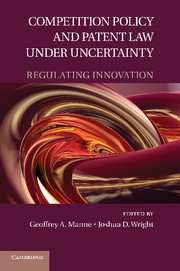Book contents
- Frontmatter
- Contents
- Contributors
- Introduction
- PART I THE INSTITUTIONS OF GROWTH
- PART II THE ECONOMICS OF INNOVATION
- PART III INNOVATION AND COMPETITION POLICY
- PART IV THE PATENT SYSTEM
- PART V PROPERTY RIGHTS AND THE THEORY OF PATENT LAW
- 12 Commercializing Property Rights in Inventions
- 13 The Modularity of Patent Law
- 14 Removing Property from Intellectual Property and (Intended?) Pernicious Impacts on Innovation and Competition
- PART VI INTELLECTUAL PROPRETY AND ANTITRUST: THE REGULATION OF STANDARD-SETTING ORGANIZATIONS
- Index
- References
12 - Commercializing Property Rights in Inventions
Lessons for Modern Patent Theory from Classic Patent Doctrine
Published online by Cambridge University Press: 05 June 2012
- Frontmatter
- Contents
- Contributors
- Introduction
- PART I THE INSTITUTIONS OF GROWTH
- PART II THE ECONOMICS OF INNOVATION
- PART III INNOVATION AND COMPETITION POLICY
- PART IV THE PATENT SYSTEM
- PART V PROPERTY RIGHTS AND THE THEORY OF PATENT LAW
- 12 Commercializing Property Rights in Inventions
- 13 The Modularity of Patent Law
- 14 Removing Property from Intellectual Property and (Intended?) Pernicious Impacts on Innovation and Competition
- PART VI INTELLECTUAL PROPRETY AND ANTITRUST: THE REGULATION OF STANDARD-SETTING ORGANIZATIONS
- Index
- References
Summary
In 1859, Abraham Lincoln famously observed that the “patent system…secured to the inventor, for a limited time, the exclusive use of his invention; and thereby added the fuel of interest to the fire of genius, in the discovery and production of new and useful things.” Lincoln understood this point all too well, as he remains the only U.S. president to have obtained a patent (which was still in force at the time he gave this speech). Today, scholars and lawyers often quote this passage from Lincoln's 1859 speech as a poetic exemplar of the long-standing policy justification for the patent system – it promotes inventive activity and progress of the useful arts by “add[ing] the fuel of interest to the fire of genius.”
Yet this invocation of President Lincoln's justification for the patent system also reflects a deep ambivalence within modern patent theory about the function of the patent system. While repeatedly quoting the latter portion of Lincoln's statement about the patent system spurring on inventive activity, modern scholars always redact the all-important first clause in which Lincoln observed that patents “secured to the inventor…the exclusive use of his invention.” In fact, given Lincoln's syntax, it is clear that he believed that it is the legal guaranty of “exclusive use” that adds “thereby” the “fuel of interest to the fire of genius.”
- Type
- Chapter
- Information
- Competition Policy and Patent Law under UncertaintyRegulating Innovation, pp. 345 - 376Publisher: Cambridge University PressPrint publication year: 2011



